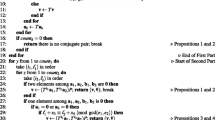Abstract
In this paper, we regard the nonlinear feedback shift register (NLFSR) as a special Boolean network, and use semi-tensor product of matrices and matrix expression of logic to convert the dynamic equations of NLFSR into an equivalent algebraic equation. Based on them, we propose some novel and generalized techniques to study NLFSR. First, a general method is presented to solve an open problem of how to obtain the properties (the number of fixed points and the cycles with different lengths) of the state sequences produced by a given NLFSR, i.e., the analysis of a given NLFSR. We then show how to construct all \(2^{2^n - (l - n)} /2^{2^n - l}\) shortest n-stage feedback shift registers (nFSR) and at least \(2^{2^n - (l - n) - 1} /2^{2^n - l - 1}\) shortest n-stage nonlinear feedback shift registers (nNLFSR) which can output a given nonperiodic/periodic sequence with length l. Besides, we propose two novel cycles joining algorithms for the construction of full-length nNLFSR. Finally, two algorithms are presented to construct \(2^{2^{n - 2} - 1}\) different full-length nNLFSRs, respectively.
Similar content being viewed by others
References
Golomb S W, Welch L R, Goldstein R M, et al. Shift Register Sequences. Laguna Hills: Aegean Park Press, 1982
Hellebrand S, Rajski J, Tarnick S, et al. Built-in test for circuits with scan based on reseeding of multiple-polynomial linear feedback shift registers. IEEE Trans Comput, 1995, 44: 223–233
Paar C, Fleischmann P, Soria-Rodriguez P. Fast arithmetic for public-key algorithms in Galois fields with composite exponents. IEEE Trans Comput, 1999, 48: 1025–1034
Moon T K, Veeramachaneni S. Linear feedback shift registers as vector quantisation codebooks. Electron Lett, 1999, 35: 1919–1920
Deepthi P P, Sathidevi P S. Design, implementation and analysis of hardware efficient stream ciphers using LFSR based hash functions. Comput Secur, 2009, 28: 229–241
Khashandarag A S, Navin A H, Mirnia M K, et al. An optimized color image steganography using LFSR and DFT techniques. In: Lin S, Huang X, eds. Advanced Research on Computer Education, Simulation and Modeling. Berlin/Heidelberg: Springer, 2011. 247–253
Choy J, Chew G, Khoo K, et al. Cryptographic properties and application of a generalized unbalanced Feistel network structure. Cryptogr Commun, 2011, 3: 141–164
Gebotys C H. Security in Embedded Devices. Springer US, 2010. 111–142
Klein A. Attacks on the RC4 stream cipher. Designs Codes Cryptogr, 2008, 48: 269–286
Zhang B, Feng D G. Improved multi-pass fast correlation attacks with applications. Sci China Inf Sci, 2011, 54: 1635–1644
Golic J D. On the linear complexity of functions of periodic GF(q) sequences. IEEE Trans Inf Theory, 1989, 35: 69–75
De Bruijn N G, Erdos P. A combinatorial problem. Indag Math, 10, 1948: 421–423
Wan Z X, Dai Z D, Liu M L, et al. Nonlinear Feedback Shift Register. Beijing: Science Press, 1978
Rizomiliotis P, Kalouptsidis N. Results on the nonlinear span of binary sequences. IEEE Trans Inf Theory, 2005, 51: 1555–1563
Rizomiliotis P, Kolokotronis N, Kalouptsidis N. On the quadratic span of binary sequences. IEEE Trans Inf Theory, 2005, 51: 1840–1848
Limniotis K, Kolokotronis N, Kalouptsidis N. On the nonlinear complexity and LempelCZiv complexity of finite length sequences. IEEE Trans Inf Theory, 2007, 53: 4293–4302
Jansen C J A, Franx W G, Boekee D E. An efficient algorithm for the generation of DeBruijn cycles. IEEE Trans Inf Theory, 1991, 37: 1475–1478
Annexstein F S. Generating de Bruijn sequences: an efficient implementation. IEEE Trans Comput, 1997, 46: 198–200
Cheng D, Dong Y. Semi-tensor product of matrices and its some applications to physics. Meth Appl Anal, 2003, 10: 565–588
Cheng D, Qi H. A linear representation of dynamics of Boolean networks. IEEE Trans Automat Contr, 2010, 55: 2251–2258
Cheng D, Qi H, Li Z. Analysis and Control of Boolean Networks: a Semi-Tensor Product Approach. London: Springer, 2011
Cheng D, Qi H, Li Z. Model construction of Boolean network via observed data. IEEE Trans Neural Netw, 2011, 22: 525–536
Cheng D. Disturbance decoupling of Boolean control networks. IEEE Trans Automat Contr, 2011, 56: 2–10
Cheng D, Qi H. Controllability and observability of Boolean control networks. Automatica, 2009, 45: 1659–1667
Cheng D, Li Z, Qi H. Realization of Boolean control networks. Automatica, 2010, 46: 62–69
Kauffman S A. Metabolic stability and epigenesis in randomly constructed genetic nets. J theor biol, 1969, 22: 437–467
Blumer A, Blumer J, Ehrenfeucht A, et al. Linear size finite automata for the set of all subwords of a word-an outline of results. Bull EATCS, 1983, 21: 12–20
Jansen C J A, Boekee D E. The shortest feedback shift register that can generate a given sequence. In: Proceedings of Advances in Cryptology. New York: Springer, 1990. 90–99
Author information
Authors and Affiliations
Corresponding author
Rights and permissions
About this article
Cite this article
Zhao, D., Peng, H., Li, L. et al. Novel way to research nonlinear feedback shift register. Sci. China Inf. Sci. 57, 1–14 (2014). https://doi.org/10.1007/s11432-013-5058-4
Received:
Accepted:
Published:
Issue Date:
DOI: https://doi.org/10.1007/s11432-013-5058-4




